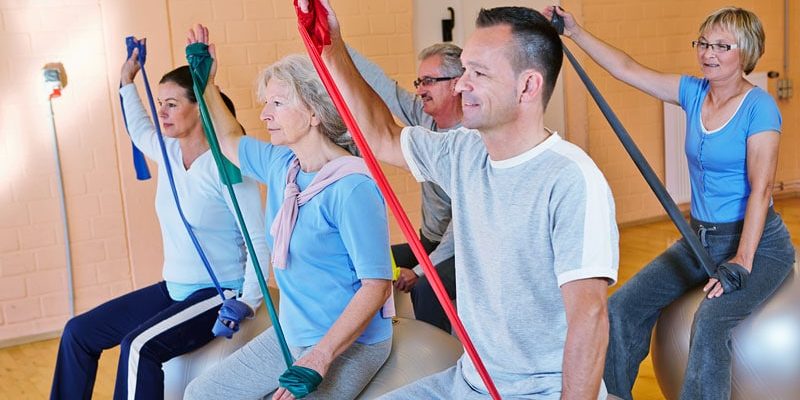Resistance training (RT) can help improve several symptoms of Parkinson’s Disease (PD) — but is not superior to other physical activities, new research suggests.
A meta-analysis, which included 18 randomized controlled trials and more than 1000 patients with PD, showed that those who underwent RT had significantly greater improvement in motor impairment, muscle strength, and mobility/balance than their peers who underwent passive or placebo interventions.
However, there was no significant difference between patients who participated in RT and those who participated in other active physical interventions, including yoga.

Romina Gollan
Overall, the results highlight the importance that these patients should participate in some type of physical exercise, the study’s lead author, Romina Gollan, MSc, assistant researcher, Division of Medical Psychology, University of Cologne, Germany, told Medscape Medical News. “Patients should definitely be doing exercises, including resistance training, if they want to. But the type of exercise is of secondary interest,” she said.
The findings were presented at the International Congress of Parkinson’s Disease and Movement Disorders (MDS) 2022.
Positive but Inconsistent
Previous reviews have suggested RT has positive effects on motor function in PD. However, results from the included studies were inconsistent; and few reviews have examined nonmotor outcomes of RT in this population, the investigators note.
After carrying out a literature search of studies that examined the effects of RT in PD, the researchers included 18 randomized controlled trials in their current review. Among the 1134 total participants, the mean age was 66 years, the mean Hoehn & Yahr stage was 2.3 (range 0-4), and the mean duration of PD was 7.5 years.
The investigation was grouped into two meta-analysis groups: one examining RT vs a passive or placebo intervention and the other assessing RT vs active physical interventions, such as yoga.
During RT, participants use their full strength to do a repetition, working muscles to overcome a certain threshold, said Gollan. In contrast, a placebo intervention is “very low intensity” and involves a much lower threshold, she added.
Passive interventions include such things as stretching where the stimulus “is not high enough for muscles to adapt” and build strength, Gollan noted.
A passive intervention might also include “treatment as usual” or normal daily routines.
Patient Preference Important
The meta-analysis comparing RT groups with passive control groups showed significant large effects on muscle strength (standard mean difference [SMD], -0.84; 95% CI, -1.29 to -0.39; P = .0003), motor impairment (SMD, -0.81; 95% CI, -1.34 to -0.27; P = .003), and mobility and balance (SMD, -1.80; 95% CI, -3.13 to -0.49; P = .007).
The review also showed significant but small effects on quality of life.
However, the meta-analysis that assessed RT vs other physical interventions showed no significant between-group differences.
Gollan noted that although there were some assessments of cognition and depression, the data were too limited to determine the impact of RT on these outcomes.
“We need more studies, especially randomized controlled trials, to investigate the effects of RT on nonmotor outcomes like depression and cognition,” she said.

Dr Ann-Kristin Folkerts
Co-investigator Ann-Kristin Folkerts, PhD, who heads the University of Cologne Medical Psychology working group, noted that although exercise in general is beneficial for patients with PD, the choice of activity should take patient preferences into consideration.
It is important that patients choose an exercise they enjoy “because otherwise they probably wouldn’t adhere to the treatment,” Folkerts told Medscape Medical News. “It’s important to have fun.”
Specific goals or objectives, such as improving quality of life or balance, should also be considered, she added.
Oversimplification?
Commenting for Medscape Medical News, Alice Nieuwboer, PhD, professor in the Department of Rehabilitation Sciences and head of the Neurorehabilitation Research Group at the University of Leuven, Belgium, disagreed that exercise type is of secondary importance in PD.
“In my view, it’s of primary interest, especially at the mid- to later stages,” said Nieuwboer, who was not involved with the research.
She noted it is difficult to carry out meta-analyses of RT vs other interventions because studies comparing different exercise types “are rather scarce.”
“Another issue is that the dose may differ, so you’re comparing apples with pears,” said Nieuwboer.
She did agree that all patients should exercise, because it is “better than no exercise,” and they should be “free to choose a mode that interests them.”
However, she stressed that exercise requires significant effort on the part of patients with PD, requires “sustained motivation,” and has to become habit-forming. This makes “exercise targeting” very important, with the target changing over the disease course, Nieuwboer said.
For example, for a patient at an early stage of the disease who can still move quite well, both RT and endurance training can improve fitness and health; but at a mid-stage, it is perhaps better for patients to work on balance and walking quality “to pre-empt the risk of falls and developing freezing,” she noted.
Later on, as movement becomes very difficult, “the exercise menu is even more restricted,” said Nieuwboer.
The bottom line is that a message saying “any movement counts” is an oversimplification, she added.
The study was funded by a grant from the German Federal Ministry of Education and Research. The investigators and Nieuwboer have reported no relevant financial relationships.
International Congress of Parkinson’s Disease and Movement Disorders (MDS) 2022: Abstract 237. Presented September 15, 2022.
For more Medscape Neurology news, join us on Facebook and Twitter
Source: Read Full Article
